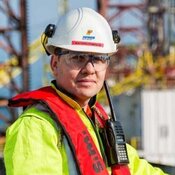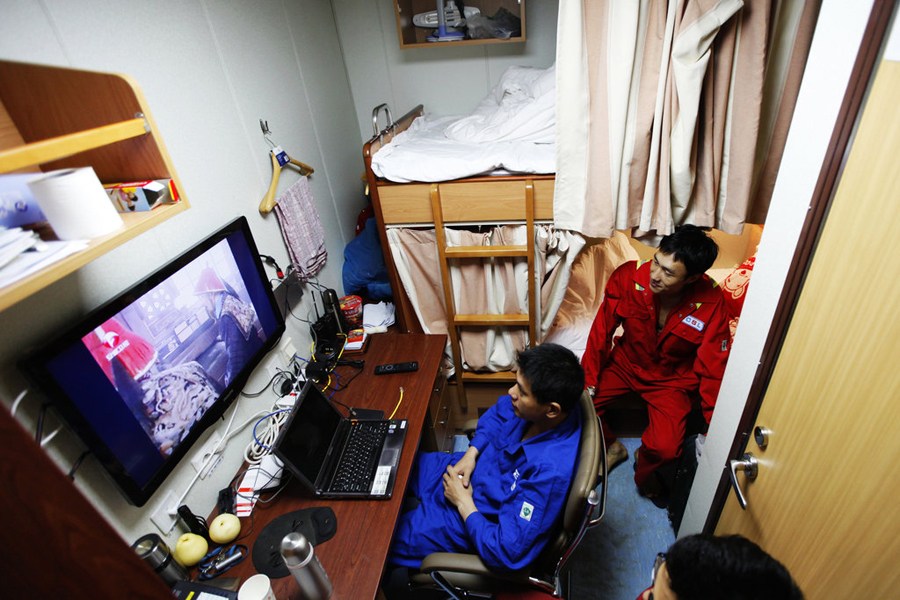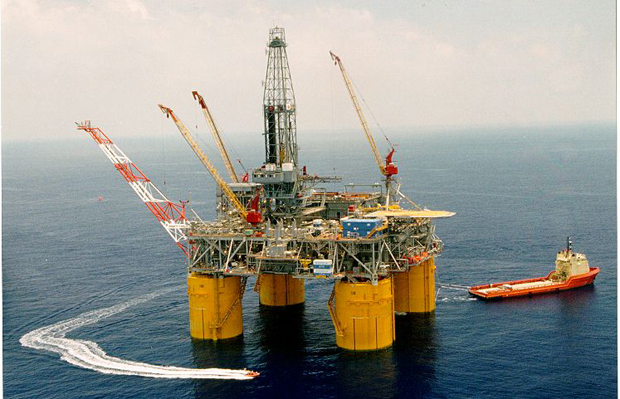Offshore platforms are among the most extreme working environments in the world, but they are also among the most attractive. Pompiliu Macovei talks about a typical day on the Petromar Central Platform in the Black Sea – about shifts, leisure time, compatibility with private life, and how to brave the wind, waves, and fog.

Pompiliu Macovei, Production Supervisor, OMV Petrom
I’ve been working on the Black Sea platform in the Black Sea for five years. I think it’s the most exciting job, but of course you have to be aware that it entails a lot of responsibility and that there’s a lot of things you have to do without.
Up to 100 people work around the clock on the platform in summer and winter, in bad weather and meter-high waves, to make sure that the wells and production operations run smoothly and safely. Technicians constantly check to make sure the installations above and around 50m-below water as well as all systems are working trouble-free. OMV Petrom has been producing oil and gas in the Black Sea about 100 kilometers off the coast of Constanta for almost three decades now. During this time a total of around 13 million tonnes of crude oil and 19 billion cubic meters of gas have been produced. “I work offshore for two weeks in a 12-hour day shift the first week and a 12-hour night shift the second week. Then I am home with my family onshore for two weeks“, says Pompiliu on his working patterns. “Only being able to see my wife once every two weeks isn’t always easy and I often miss out on important family occasions. Put simply, you have to plan your time onshore really well, but I am used to that from my job”, he says.

Running like clockwork, day in day out
Pompiliu’s day starts with the shift change, and then it’s time for a planning meeting. The Romanian compiles production reports, conducts production test programs, is responsible for the trouble-free flow of the oil and gas that’s been produced, and supervises the water injection program and pipelines underwater. “I always like to take on any new challenge that improves the production process. In order to stay sharp for my job, we have regular special offshore technology, safety, and survival training. This way I can continue developing my skills and expertise. Our health and safety skills are an essential part of our company culture. It is our responsibility to question anything and everything, should safety be in doubt,” says Pompiliu. But collegiality also plays a major role offshore, because it’s a team job. “We have to be well coordinated, talk to each other a lot, and support each other to make the right decisions for production and safety procedures.”
At the mercy of the elements
The only way for Pompiliu and his colleagues to get to work and back to Constanta’s harbor is by helicopter, and then only when the weather is good. But what if his trip home is delayed because of bad weather? “You have to be prepared for that. Transport between the platforms and the shore can only run if the weather conditions are favorable – ‘safety first’ applies here too. In spring it is sometimes so foggy that the helicopter can’t operate for days. In winter we often have winds of up to 160 km/h and 11 to 12-meter waves. We just have to be patient. But you learn this quickly when you decide to take a job offshore. The result is that we look forward to home and our families all the more”.
Table tennis on the high seas
What does one do for recreation on the high seas, far away from restaurants, cinemas and football pitches? “After my shift I try to relax as much as possible. We have internet and can watch TV in various common rooms; of course I also speak to my family a lot on the phone. But staying fit is also important – I spend a lot of time in the gym and it’s never boring when you can play pool or table tennis with colleagues”.
But why not see for yourself how life works on an offshore platform:
A special event – visit of the “Uranus”
But it’s not only the crew that has to stay fit for living and working offshore. From time to time the Petromar Central Platform also needs a fitness unit: for example when more extensive repairs are needed. Then a mobile offshore drilling rig is rented – as was the case a few months ago. “Visits” like this are something special even for Pompiliu: “Mobile drilling rigs like ‘Uranus’ help to ensure that our production from the Black Sea stays at maximum level 365 days a year. We don’t get a visit from a drilling rig like this every day – docking always is a challenge and a major event in what is already a very special job”.
Have a look at our video to accompany the 6,634-tonne mobile drilling rig on its journey from Constanta’s harbor to Petromar Central Platform and find out just how much work is involved in the simple word “docking”.
Life on Board a Gulf of Mexico Oil Drilling Platform
The people of Ursa, Shell’s $1.45 billion oil-and-gas platform, live 65 miles offshore, in an environment that is demanding and dangerous, and that could drive them crazy. Here’s how they work — and how they cope.

This story was originally published in September 2000, but it offers an insight into a aspect of the Gulf oil spill coverage that’s been overlooked in recent coverage: life on board an oil rig — in this case, Shell Oil’s Ursa platform (above). At the time of original publication it was a brand new, state-of-the-art operation.
“Good morning, it’s 5 o’clock!”
No, this is not a personalized wake-up call from a soft-spoken hotel operator. It’s a different kind of reveille, one that begins with a brisk knock at the door, continues with that chirpy greeting, and ends with the overhead fluorescent lights flipping on. It’s the way that every day starts on Ursa, Shell Oil’s newest production-and-drilling platform in the deep waters off the coast of Louisiana. And if that greeting doesn’t get you up, a personalized call may go out over the loudspeaker, telling you to get out of bed and get down to the galley.
One hour later, at 6 a.m., a staff meeting begins with a group of workers ambling in, dressed in baseball caps and shirts with name patches that read “Maxie,” “Boots,” “Buster,” and “Princess.” Some of the workers sport monogrammed overalls. Until the meeting comes to order, the only conversation is intense trash-talking about an impending platformwide Ping-Pong tournament.
Nothing in such friendly banter would suggest that this wisecracking bunch is in charge of an oil-and-gas platform that cost $1.45 billion to build and is the size of two football fields. But the cost is only one part of the equation: Deep-water drilling is also enormously complex, with a number of workplace constraints — some technological, some human. As a consequence, the men and women of Ursa, about 250 people who went through a rigorous audition process to make the cut, need to be a special breed. The job demands that employees work long hours in close quarters, do demanding and sometimes dangerous work without driving one another crazy — or else go nuts themselves. How do they do it?
Team Ursa
Ursa operates 24 hours a day, 365 days a year. With oil currently selling at around $30 per barrel, and Ursa producing about 100,000 barrels of oil per day, it doesn’t make economic sense to unplug the operation — as long as everything is functioning smoothly. The challenge, of course, is for everything to function smoothly. One mistake, and Ursa could join the Exxon Valdez in the oil-and-environmental-disaster history books. Those challenges are something that Rick Fox, Shell’s asset leader for Ursa, knew three years ago when he set out to assemble the team that would help build and staff the platform in preparation for “first oil” in March 1999.
Fox, a 25-year veteran of Shell who’s tackled projects as far afield as Brazil and Syria, is a student of the writings of several management gurus. And for this assignment, he set his sights on something more than good teamwork. “I figured this would be my last shot at building an organization,” says Fox, 48, “and I really wanted to know whether we could create a better place to work. We needed a high level of creativity, but on other platforms, we hadn’t shared information well enough. And at $1 billion plus in costs, we couldn’t afford any lack of communication. We had to be stone-cold good at everything.”
Building a better workplace began with the way that the platform was designed. Thanks to space-age three-dimensional design software, Fox and his team were able to participate in the design process in finer detail and at an earlier stage than his predecessors were able to on similar projects. “For example, we were able to think about how we wanted to walk around a particular piece of equipment as we inspected it, and we were able to design that in ahead of time,” says Sam Mabry, a 39-year-old control-room operator on Ursa. “That sort of thing makes a big difference once you’re out there working.” Another improvement that got designed into the platform’s environment: enough space so that drillers, operations people, and production workers could all have their own data rooms.
An even greater challenge was to match people to the platform. Executives at Shell made it clear that Ursa could not be staffed simply by reassigning the most experienced workers from the company’s three other tension-leg platforms. So it was up to Fox and his team to find and then to evaluate candidates who had little prior experience in the energy business. “To us, that just created an opportunity to bring in people from elsewhere who could add value to the system because they didn’t see things the way we saw them,” says Arthur McAlpin, 44, one of two on-platform managers who report directly to Fox, whose office is in New Orleans. While many people did transfer out to Ursa from Shell operations onshore, others had most recently worked on submarines, repaired cardiac equipment, and trolled the shopping aisles of Home Depot.
What does it take to assemble a high-performing team to work on a drilling rig? “We weren’t just looking for technical ability,” says Todd Hooker, 36, a control-room operator. “We were looking for communication skills. We had one exercise called ‘Lost on the Moon,’ where we asked a small group to think about which tools they’d need if they were on one side of the moon and wanted to get to the other side. We wanted to see who took leadership positions and who was argumentative.”
Life On the Platform
The helicopters leave every Tuesday from Venice, Louisiana for the 45-minute trip to Ursa, carrying out the new workers who are starting a shift, bringing back those who’ve completed one. At any given time, there are roughly 120 workers out on the platform. Most of them work a 14-day shift on Ursa, then take 14 days off. When they’re on, they work for 12 to 14 hours each day. The day shift and the night shift start their 14-day hitches on alternating weeks. “That way, there’s always someone out there who has been on the platform for at least one week and is aware of any problems,” says Fox.
While few of the platform workers have formal training in engineering, most of them have self-taught, learned-on-the-job mechanical skills, in addition to expertise in certain drilling or production machinery. On the platform, any one of those skills can turn out to be vital. “I learned an incredible amount from those guys when I spent a year offshore in 1987,” says Verlon Kiel, 42, an engineer himself, who works onshore monitoring production on Ursa. “When problems happen out there, if the weather is bad or the seas are rough, it may be days before help can come out. So the people who are working out there become the repairmen who fix things.”
During the few waking hours when they’re not working, platform workers’ lives revolve mostly around food. Shell uses a catering company to run its galley, and the staff of six people produces a bounty of comfort food for breakfast, lunch, dinner, and a midnight meal. “It’s not a job to us,” says Dawn Best, 66, a perpetually smiling member of the catering crew who is affectionately known as “Miss Dawn.” “We’re more like family out here. I have three sons who work offshore for other companies, so I treat all of the workers here the way I’d want people to treat my boys.”
For those who visit it a bit too often, the buffet line creates its own requirement: the need to exercise. Several world-class Ping-Pong players work on Ursa, and foosball is also a popular sport. Thanks to Ursa’s satellite hookup, cable TV is in every room, and Internet access is available in the offices and in the library. While there is no hardship pay for working offshore, entry-level roustabouts on the drilling rig still begin at about $30,000 per year. Since there’s nowhere to spend that money on the platform, many workers gravitate to Internet investing. “A lot of these guys will retire as millionaires if they’re smart,” says John Guyett, 49, a drilling foreman on Ursa.
Life Off the Platform
Working 14 days on, 14 days off and feeling the pressure to perform under exacting conditions can make life on the platform grueling. But for many workers, the schedule offers substantial benefits — off the platform. “Before I came offshore to work a 14/14, I was working a job that was labeled ‘5/2,’ ” says Marvin Blanchard, 39, an operations foreman. “But really, it was a 6/1 job. I’d leave home before daylight and get back after dark. Now I have built-in balance. But it took me a while to get used to it.”
Because they have to make only one round-trip each month for the 45-minute flight out of the heliport at the tip of Louisiana, many of Ursa’s workers buy land and build their dream houses all over the south, from east Texas to the Florida panhandle. One worker even flies in from Montana each month in his own plane. But, ultimately, every platform worker has to come to terms with the reality of family life when the job means being away from home for six months of the year. “It’s always difficult to leave home and come back out here,” says Blanchard. Adds McAlpin: “Choosing to work this way is not a decision that you make lightly, or by yourself.”
For some people, work-life balance is a math problem: Royce Thomason, 45, an associate technician on Ursa, calculates his odds of being at home with his family at 50-50. That said, he recently missed his daughter’s 16th birthday. “We threw a big birthday party before I left,” he says. Others take a more qualitative approach. “Most people who work on the production or the drilling side of this business move around a lot, and that’s very difficult for young children,” says Guyett. “So I actually tried to get offshore, because it was the easiest way for my family to establish roots in one place.”
While several workers on Ursa are divorced and are unable to have full custody of their children because of their schedules, the percentage of single parents on Ursa doesn’t appear to be especially high. Male workers (only a handful of women work on Ursa) chalk that up in part to their dutiful completion of the “honey do’s” that pile up while they’re gone: “When we get home, what we hear is ‘Honey, now that you’re back, could you please do the windows!’ or ‘Honey, please do the lawn!’ ” jokes Tommy Chreene, 45, a systems mechanic.
In fact, the workers on Ursa don’t leave their families behind when they’re on the platform: They bring their families with them, and they share their concerns with their fellow workers. “We’re all aware of one another’s family interests and concerns, and we’re able to talk about them quite openly,” says Blanchard. “People who don’t eat and sleep with their coworkers for 14 days have no idea how close we are.”
Ron Lieber ([email protected]) is a Fast Company senior writer. Visit Ursa on the Web (www.offshore-technology.com/projects/ursa).





